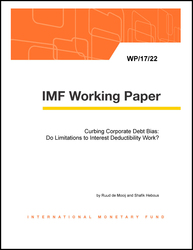
Curbing Corporate Debt Bias
Tax provisions favoring corporate debt over equity finance (“debt bias”) are widely recognized as a risk to financial stability. This paper explores whether and how thin-capitalization rules, which restrict interest deductibility beyond a certain amount, affect corporate debt ratios and mitigate financial stability risk. We find that rules targeted at related party borrowing (the majority of today’s rules) have no significant impact on debt bias—which relates to third-party borrowing. Also, these rules have no effect on broader indicators of firm financial distress. Rules applying to all debt, in contrast, turn out to be effective: the presence of such a rule reduces the debt-asset ratio in an average company by 5 percentage points; and they reduce the probability for a firm to be in financial distress by 5 percent. Debt ratios are found to be more responsive to thin capitalization rules in industries characterized by a high share of tangible assets.
Publication date: January 2017
ISBN: 9781475573053
$18.00
Add to Cart by clicking price of the language and format you'd like to purchase
Available Languages and Formats
| English |
Prices in red indicate formats that are not yet available but are forthcoming.
Topics covered in this book
This title contains information about the following subjects.
Click on a subject if you would like to see other titles with the same subjects.
Corporate tax , capital structure , debt bias , thin capitalization rule
Summary
Copyright © 2010 - 2024
Powered by:
AIDC



